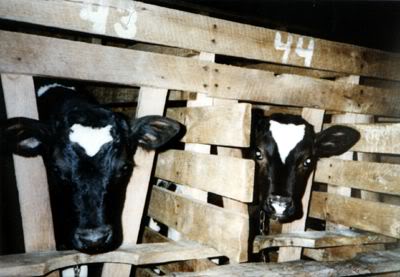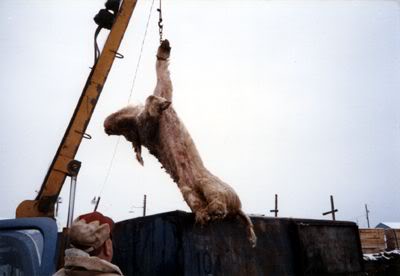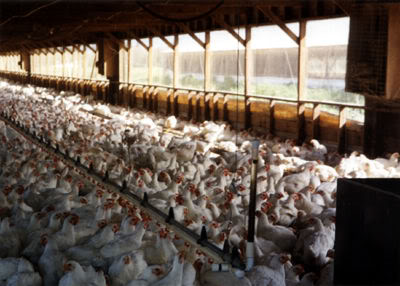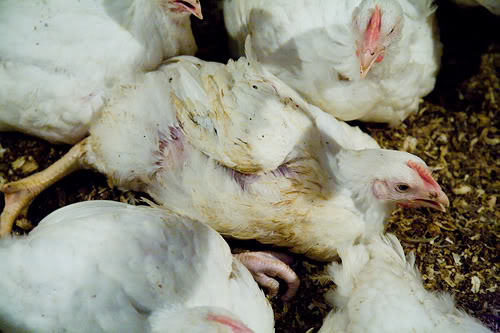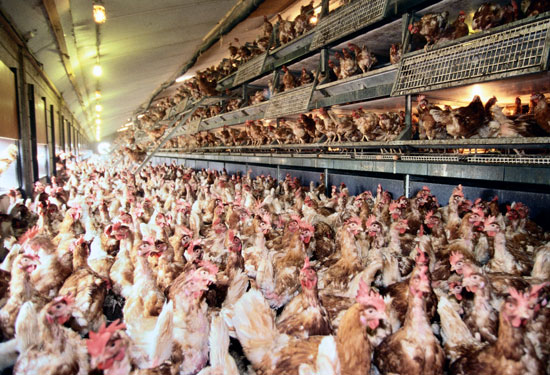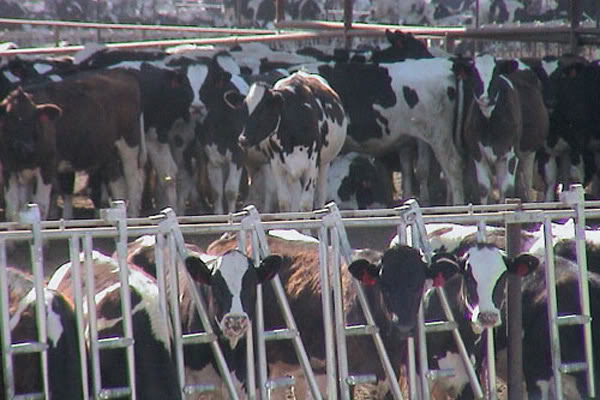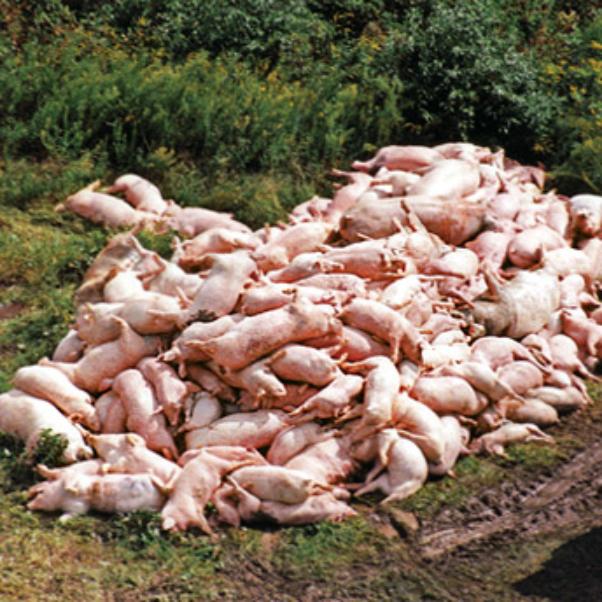Translate This Page
Our society is showered with images of happy animals living on farms where the cows graze in lush green fields and the chickens have the run of the barnyard. This vision of free-roaming animals living out their days in sunny fields is very far from the reality. A majority of the animals that are raised for food live miserable lives in intensive confinement in dark, overcrowded facilities, commonly called "factory farms." Unfortunately, this trend of mass production has resulted in incredible pain and suffering for the animals. Animals today raised on factory farms have had their genes manipulated and pumped full of antibiotics, hormones and other chemicals to encourage high productivity. In the food industry, animals are not considered animals at all; they are food producing machines. They are confined to small cages with metal bars, ammonia-filled air and artificial lighting or no lighting at all. They are subjected to horrible mutilations: beak searing, tail docking, ear cutting and castration. Even the most minimum humane standards proposed are thwarted by the powerful food conglomerates.
Factory farming began in the 1920s soon after the discovery of vitamins A and D; when these vitamins are added to feed, animals no longer require exercise and sunlight for growth. This allowed large numbers of animals to be raised indoors year-round. The greatest problem that was faced in raising these animals indoors was the spread of disease, which was combated in the 1940s with the development of antibiotics. Farmers found they could increase productivity and reduce the operating costs by using mechanization and assembly-line techniques.
It is estimated that 90% of all pigs raised for food are confined at some point in their lives. Pigs are highly social, affectionate and intelligent creatures, and suffer both physically and emotionally when they are confined in narrow cages where they cannot even turn around. Many pigs become crazy with boredom and develop vices like mouthing, and nervous ticks; others are driven to fighting and cannibalism because of their frustration. Pigs are born and raised inside buildings that have automated water, feed and waste removal. They don't see daylight until they are shipped for slaughter. Dust, dirt and toxic gases from the pigs' waste create an unsanitary environment that encourages the onset of a number of diseases and illnesses, including pneumonia, cholera, dysentery and trichinosis.
The veal industry is notorious for the cruel confinement of calves. Calves are kept in small crates which prevent movement inhibit muscle growth so their flesh will be tender. They are also fed a diet deficient of iron to keep their flesh pale and appealing to the consumer. Veal calves spend each day confined alone with no companionship and are deprived of light for a large portion of their four-month lives.
Dairy cows are bred today for high milk production. For cows who are injected with Bovine Growth Hormone, their already high rate of milk production is doubled. Half of the cows in the national dairy herd are raised in intensive confinement, where they suffer emotionally from being socially deprived and being prohibited from natural behavior. Dairy cows produce milk for about 10 months after giving birth so they are impregnated continuously to keep up the milk flow. Female calves are kept to replenish the herd and male calves are usually sent to veal crates where they live a miserable existence until their slaughter. When cows become unable to produce adequate amounts of milk they are sent to slaughter so money can be made from their flesh. The cows are kept in a holding facility where they are fed, watered and have their waste removed mechanically and are allowed out only twice a day to be milked by machines.
Animals raised in confinement create an ideal setting for bacteria and disease to spread rapidly. Antibiotics were developed around the time of World War II and were soon adapted into the farming system. In the U.S., almost 50% of all antibiotics are administered to farm animals. These drugs form a toxic residue in animal tissue. It is much of this same tissue that is sold to consumers as food products. Each year, we see an increase in the number of salmonella poisoning cases from contaminated eggs, meat and milk. These strains of salmonella are difficult to treat because they are antibiotic resistant. Antibiotics are not the only chemicals administered to factory farm animals; many animals are fed growth-promoting hormones, appetite stimulants and pesticides, fertilizers, herbicides and aflatoxins that collect in the animals' tissues and milk
Mechanized Madness...
Deprivation and Disease
The factory-farming system of modern agriculture strives to produce the most meat, milk, and eggs as quickly and cheaply as possible—and in the smallest amount of space possible. Cows, calves, pigs, chickens, turkeys, ducks, geese, rabbits, and other animals are kept in small cages or stalls, where they are often unable to turn around. They are deprived of exercise so that all their energy goes toward producing flesh, eggs, or milk for human consumption. They are fed drugs that fatten them faster, and they are genetically manipulated to grow faster or produce much more milk or eggs than they would naturally.
Because crowding creates an atmosphere that welcomes disease, animals on factory farms are fed and sprayed with huge amounts of pesticides and antibiotics, which remain in their bodies and are passed on to the people who consume them, creating serious human health hazards. While the Food and Drug Administration, the Centers for Disease Control and Prevention, and the U.S. Department of Agriculture (USDA) have called the use of antibiotics in this manner of “serious emerging concern,” the industry simply could not continue to raise billions of animals per year in such cramped, filthy conditions without the drugs that allow animals to survive conditions that would otherwise kill them.
Chickens
Chickens are inquisitive animals, and in their natural surroundings, they form friendships and social hierarchies, recognize one another and develop pecking orders, love and care for their young, and enjoy full lives that include dust-bathing, making nests, and roosting in trees. On factory farms, however, chickens are denied these activities and suffer because of it.
Laying hens live in battery cages stacked tier upon tier in huge warehouses. Confined seven or eight to a cage, they don’t have enough room to turn around or spread even one wing. Conveyor belts bring in food and water and carry away eggs. Farmers often induce greater egg production through “forced molting”: Chickens are denied food and light for days, which leads to feather and weight loss.
To prevent stress-induced behaviors caused by extreme crowding—such as pecking their cagemates to death—hens are typically kept in semi-darkness, and the ends of their sensitive beaks are cut off with hot blades without any painkillers. The wire mesh of the cages rubs their feathers and skin off and causes their feet to become crippled. Chickens can live for more than a decade, but laying hens on factory farms are exhausted and unable to produce as many eggs by the time they are 2 years old, so they are slaughtered. More than 100 million “spent” hens die in slaughterhouses each year. Ninety-eight percent of the egg industry’s hens are confined to cages on factory farms.
More than 9 billion “broiler” chickens are raised in sheds each year. Artificial lighting is manipulated to keep the birds eating as often as possible. To keep up with demand and to reduce production costs, genetic selection calls for big birds and fast growth (it now takes only six weeks to “grow out” a chick to “processing” weight), which causes extremely painful joint and bone conditions. Undercover investigations into the “broiler” chicken industry have revealed that birds routinely suffer from dehydration, respiratory diseases, bacterial infections, heart attacks, crippled legs, and other serious ailments.
At the slaughterhouse, chickens are hung upside down, their legs are forced into metal shackles, their throats are cut, and they are immersed in scalding-hot water in defeathering tanks. They are often conscious throughout the entire process..
Cattle
Cows who are free to roam pastures and care for their young form life-long friendships with one another and have demonstrated the ability to be vain, hold grudges, solve problems, and play games. But cows raised for the meat and dairy industries are often far removed from lush pastures and nursing calves.
Cattle raised for beef may be born in one state, fattened in another, and slaughtered in yet another. They are fed an unnatural diet of high-bulk grains and other “fillers,” which can include expired dog and cat food, poultry feces, and leftover restaurant food. They are castrated, their horns are ripped out, and they have third-degree burns inflicted on them (branding)—all without any painkillers. During transportation, cattle are crowded onto trucks, where they suffer from trampling and temperature extremes and lack food, water, and veterinary care. At the slaughterhouse, cattle may be hoisted upside down by their hind legs and dismembered while they are still conscious. The kill rate in a typical slaughterhouse is 400 animals per hour, and “the line is never stopped simply because an animal is alive,” according to slaughterhouse workers.
Calves raised for veal are the male offspring of dairy cows. They’re taken from their mothers within a few days of birth, and they are chained in stalls that have slatted floors and are only 2 feet wide and 6 feet long. Since their mothers’ milk is used for human consumption, the calves are fed a milk substitute that is designed to help them gain at least 2 pounds a day. The diet is purposely low in iron so that the calves become anemic and their flesh stays pale and tender.
Pigs
Pigs are very clean animals who take to the mud primarily to cool off and evade flies. They are just as friendly and gregarious as dogs, and according to Professor Donald Broom at the Cambridge University Veterinary School, “They have the cognitive ability to be quite sophisticated. Even more so than dogs and certainly three-year-olds.” Mother pigs on factory farms in the U.S. spend most of their lives confined to crates that measure 7 feet long and 2 feet wide, barely larger than the pigs themselves. They display signs of extreme boredom and stress, such as biting the bars of their cages and gnashing their teeth. Their piglets are taken away three weeks after birth and packed into pens until they are singled out to be raised for breeding or for meat. Like chickens and turkeys, pigs are genetically manipulated and pumped full of drugs, and many become crippled under their own weight. Although pigs are naturally affable and social animals, the confinement of these crowded pens causes neurotic behaviors such as cannibalism and tail-biting, so farmers cut off piglets’ tails without any painkillers and use pliers to break off the ends of piglets’ teeth.
Pigs are transported through all weather extremes, often freezing to the sides of transport trucks in leading pig-slaughtering states such as Iowa and Nebraska, or dying from dehydration in states such as North Carolina. According to industry statistics, more than 1 million pigs die en route to slaughter each year.
At the slaughterhouse, improper stunning means that many pigs reach the scalding-hot water baths—which are intended to soften their skin and remove their hair—while they are still conscious.
Environmental and Health Concerns
Factory farms are harmful to the environment as well as being cruel to animals. The 3 trillion pounds of waste produced by factory-farmed animals each year are usually sprayed on fields, and they subsequently run off into waterways—along with the drugs and bacteria that they contain. According to the EPA, agricultural runoff is the number one source of water pollution.
Two-thirds of all agricultural land in the U.S. is used to raise animals for food or to grow grain to feed them. Chickens, pigs, cattle, and other animals raised for food are the primary consumers of water in the U.S.—a single pig consumes 21 gallons of drinking water per day, while a cow on a dairy farm drinks as much as 50 gallons daily. It takes more than 2,400 gallons of water to produce 1 pound of cow flesh, whereas it takes about 180 gallons of water to produce 1 pound of whole-wheat flour.
Food-related illnesses affect more than 76 million people annually and kill more than 5,000. Consumer Reports found that two-thirds of chickens studied were infected with either salmonella or campylobacter or both. Eggs pose a salmonella threat to approximately one out of every 50 people each year in some parts of the U.S. Potentially deadly E. coli bacteria sickens more than 62,000 people each year, and the USDA reports that most of the cattle slaughtered for food in the U.S. are likely infected with it.
What You Can Do
Support legislation that abolishes battery cages, veal crates, and intensive-confinement systems. The United Kingdom prohibits the use of gestation crates and veal crates. The European Union is phasing out the use of battery cages as of 2012.
The best way to save animals from the misery of factory farming is to stop consuming meat, dairy foods, and eggs. Veganism means eating for life: yours and animals
BENEFITS OF A VEG DIET .........
Conserves up to 70% clean water
Saves over 70% of the Amazonian rainforest from clearance for animal grazing
A solution for world hunger:
Free up 3,433 million hectares of land annually
Free up 760 million tons of grain every year (half the worlds grain supply)
Consumes 2/3 less fossil fuels than those used for meat production.
Reduces pollution from untreated animal waste
Maintains cleaner air
Saves 4.5 tons of emissions per household per year
Stop 80% of global warming
Lower blood pressure
Lower cholesterol levels
Reduce Type 2 diabetes
Prevent stroke conditions
Reverse atherosclerosis
Reduce heart disease risk by 50%
Reduce heart surgery risk by 80%
Prevent many forms of cancer
Stronger immune system
Increase life expectancy up to 15 years
Higher IQ
